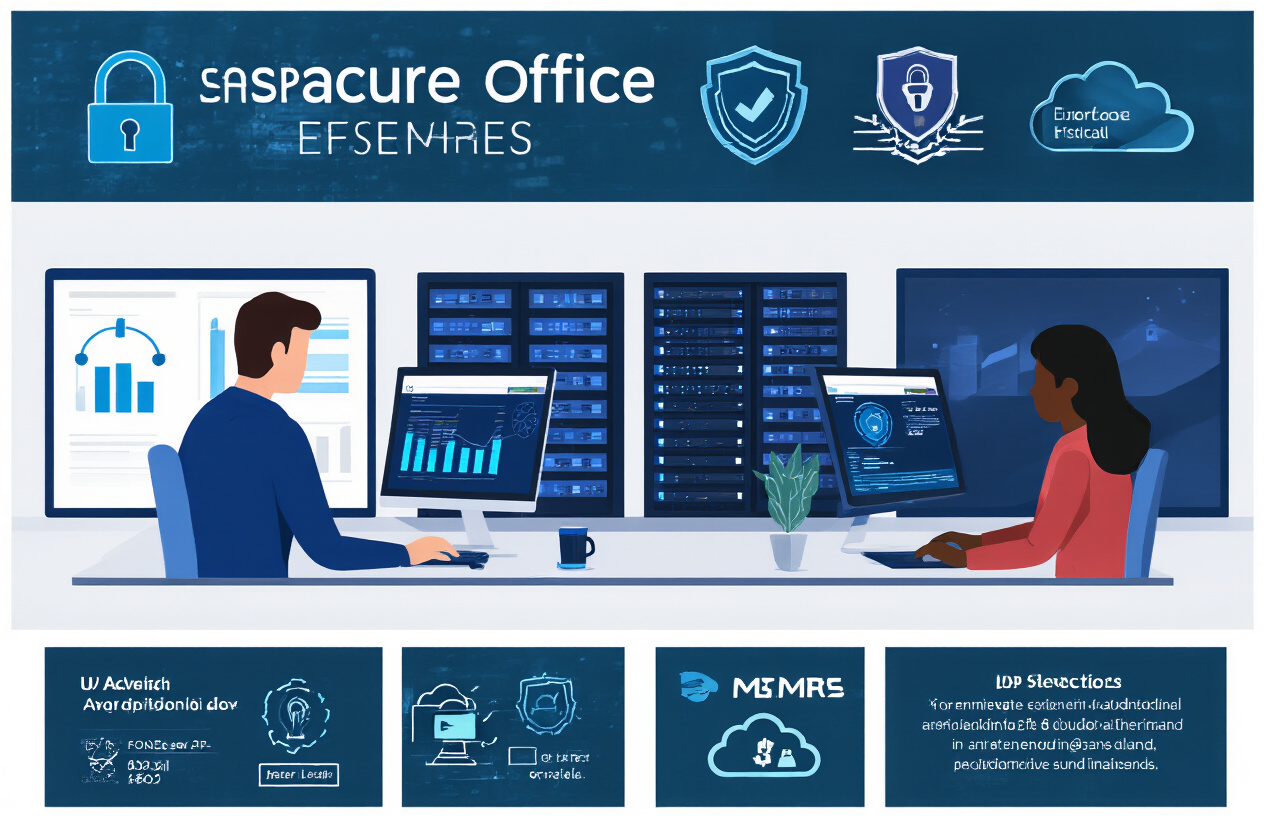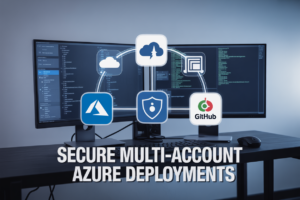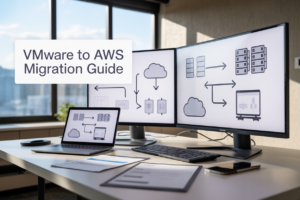Ever stared at a $100,000+ CMMC non-compliance fine and felt that cold sweat moment? Yeah, defense contractors know that feeling all too well.
Here’s the brutal truth: navigating DFARS and CMMC compliance in the cloud isn’t just a headache—it’s a minefield where one wrong step can cost your business everything.
GCC High and Azure provide the secure cloud hosting environment defense contractors desperately need. These platforms aren’t just “government approved”—they’re specifically engineered for handling controlled unclassified information while maintaining the strict security requirements that keep the Pentagon happy.
But here’s what most compliance articles won’t tell you about these solutions…
Understanding GCC High and Its Role in Defense Contracting

A. What is GCC High and how it differs from commercial Microsoft offerings
GCC High is Microsoft’s specialized cloud environment built specifically for defense contractors and federal agencies dealing with controlled unclassified information (CUI). It’s not just a slight upgrade from commercial offerings—it’s a completely separate infrastructure.
Think of it this way: commercial Microsoft 365 is like a regular apartment building, while GCC High is a military-grade fortress with armed guards and retinal scanners.
The key differences are stark:
| Feature | Commercial Microsoft | GCC High |
|---|---|---|
| Data residency | Global data centers | US soil only, operated by screened US personnel |
| Support staff | Global team | US persons only with background checks |
| Encryption | Standard | Enhanced FIPS 140-2 compliant |
| Feature updates | Immediate | Delayed (security-vetted) |
| Price | Lower | Significantly higher |
| Minimum seats | No minimum | Typically 500+ seat minimum |
GCC High also strips away consumer-oriented features that might create security risks. You won’t find Clippy or cute cat GIFs here—just hardened, defense-ready infrastructure.
B. Key security features tailored for defense contractors
Defense contractors aren’t just dealing with quarterly reports—they’re handling information that could impact national security. GCC High delivers security features that match these high stakes:
-
Zero standing access means Microsoft engineers can’t just peek at your data. Access requires rigorous approval processes with full audit trails.
-
CNSA-compliant cryptography uses the strongest available encryption algorithms approved for national security systems.
-
Physical isolation separates your environment from commercial clouds—no shared resources or potential cross-contamination.
-
Advanced threat protection includes specialized tools that identify suspicious patterns tied to nation-state actors and advanced persistent threats.
-
Dedicated Azure Active Directory creates a walled garden for identity management, completely separate from commercial AAD instances.
The multi-layered security approach mirrors military defense strategies—multiple reinforcing controls with no single point of failure.
C. Why GCC High meets DFARS requirements
DFARS 7012 requirements aren’t suggestions—they’re contractual obligations with serious teeth. GCC High isn’t just compliant; it was designed from the ground up with these requirements in mind.
The match is perfect for several reasons:
-
DFARS requires CUI to remain within US borders. GCC High guarantees this with its US-only data centers and US person-only support teams.
-
The regulation demands incident reporting within 72 hours. GCC High has built-in processes specifically for defense industrial base reporting requirements.
-
All cloud service providers must implement NIST 800-171 controls. GCC High covers these comprehensively, with additional controls to address emerging threats.
Contractors using standard commercial clouds often cobble together complicated compliance solutions. GCC High eliminates this headache with built-in compliance.
D. The relationship between GCC High and Azure Government
GCC High and Azure Government are close cousins in Microsoft’s specialized government cloud offerings. They share DNA but serve slightly different purposes.
Azure Government provides the infrastructure backbone that powers GCC High. While GCC High focuses on Microsoft 365 services (Email, Teams, SharePoint), Azure Government delivers the IaaS and PaaS capabilities needed for custom applications and workloads.
Defense contractors typically need both:
- GCC High for day-to-day productivity and collaboration
- Azure Government for custom applications and development environments
They’re designed to work seamlessly together, sharing authentication systems and network connectivity. This creates a complete ecosystem for defense contractors that spans everything from email to custom military application development.
The relationship enables contractors to maintain compliance across their entire IT landscape without creating security gaps between systems.
DFARS and CMMC Compliance Requirements Explained

A. Breakdown of DFARS 7012 requirements for cloud systems
Defense contractors are drowning in acronyms, but DFARS 7012 is one you can’t ignore. This clause requires you to:
- Provide “adequate security” for covered defense information
- Report cyber incidents within 72 hours (yes, that’s just three days)
- Submit malicious software to DoD Cyber Crime Center
- Preserve and provide access to affected media for DoD analysis
- Flow down these requirements to subcontractors
Here’s the kicker – when you use cloud services, you need providers who can meet FedRAMP Moderate baseline as a minimum. Your cloud provider also needs to comply with security requirements equivalent to those in NIST SP 800-171.
B. Current CMMC 2.0 framework overview
CMMC 2.0 simplified things from the original version, thank goodness. The framework now has three levels instead of five:
| Level | Description | Requirements |
|---|---|---|
| Level 1 | Foundational | 17 practices from FAR 52.204-21 |
| Level 2 | Advanced | All 110 practices from NIST SP 800-171 |
| Level 3 | Expert | NIST SP 800-171 plus additional practices |
Most defense contractors handling CUI will need Level 2 certification. The good news? Self-assessment is allowed for some contracts at Level 2, depending on the criticality of the information.
C. Specific controlled unclassified information (CUI) protections
CUI isn’t just regular data with a fancy name. It requires serious protection, including:
- Access controls limiting system access to authorized users
- Audit capabilities that track unauthorized access attempts
- Multi-factor authentication for privileged accounts and network access
- Encryption of data at rest and in transit
- Media protection when storing or transporting CUI
- Physical safeguards for systems processing CUI
Think of CUI as information that isn’t classified but would be really bad if it fell into the wrong hands.
D. Compliance deadlines and enforcement mechanisms
The DoD isn’t playing around with compliance timelines:
- CMMC requirements are being phased into new DoD contracts
- By 2026, all defense contracts involving CUI will require CMMC certification
- Assessment results must be submitted to the Supplier Performance Risk System (SPRS)
- Third-party assessment organizations (C3PAOs) will verify compliance for many contracts
The Pentagon has made it clear – no certification, no contract. They’re using a “trust but verify” approach through the CMMC Accreditation Body.
E. Penalties for non-compliance
Missing the mark on DFARS and CMMC compliance isn’t a slap-on-the-wrist situation. Penalties can include:
- Contract termination – say goodbye to that revenue stream
- Suspension from future contract opportunities
- False Claims Act violations carrying penalties up to $23,000 per false claim
- Reputational damage in the defense industrial base
- Potential criminal charges for willful non-compliance
Some contractors learned this lesson the hard way. Aerojet Rocketdyne settled a whistleblower case for $9 million after allegedly misrepresenting their NIST SP 800-171 compliance.
Azure’s Security Architecture for Defense Contractors

Physical and Logical Isolation Benefits
The defense industry isn’t playing around when it comes to security – and neither is Azure. Unlike commercial cloud environments, Azure’s architecture for defense contractors creates true air gaps between your sensitive data and everyone else’s.
This isn’t your standard multi-tenant setup. Azure physically separates the infrastructure used for defense contractors from commercial environments. Different hardware, different networks, different everything. Your classified data never shares physical space with commercial data.
Logically, the separation goes even deeper. Unique authentication boundaries mean that even Microsoft’s own administrators can’t access your environments without proper clearance. This creates multiple security layers that protect against both external threats and insider risks.
US Personnel Screening Requirements
Azure doesn’t just put anyone behind the wheel of defense systems. Every person with potential access to GCC High environments undergoes rigorous background checks. We’re talking US citizenship verification, security clearances, and continuous vetting.
This human firewall matters as much as any technical control. Azure’s screening process means the people managing your defense data are vetted to the same standards as your own team.
Enhanced Threat Detection Capabilities
Commercial threat detection is good. Defense-grade threat detection is on another level.
Azure’s security stack for defense contractors includes specialized monitoring systems that understand the unique threat landscape facing defense organizations. These systems:
- Detect nation-state attack patterns specifically targeting defense intellectual property
- Monitor for unusual data access patterns that might indicate espionage
- Deploy counter-measures designed for advanced persistent threats
Data Residency Guarantees
Where your data lives matters for compliance. Azure doesn’t just promise your defense data stays in the US – they guarantee it through contractual, technical, and physical controls.
All data processing, storage, and management occurs exclusively within US borders. This isn’t just about meeting a checkbox requirement – it’s about ensuring your ITAR-controlled technical data never leaves US jurisdiction.
Implementing GCC High for Your Organization

A. Migration planning considerations
Switching to GCC High isn’t like flipping a switch. You need a solid game plan before diving in.
First, inventory your existing systems and data. What needs to move? What can stay put? Identifying CUI (Controlled Unclassified Information) is crucial here – not everything requires the heightened security of GCC High.
Your identity management strategy needs serious thought too. GCC High requires its own Azure AD tenant, separate from your commercial environment. This means potentially managing multiple identities or implementing complex federation scenarios.
Application compatibility is another hurdle. Not all apps that run in commercial Azure work in GCC High. You’ll need to validate each one or potentially redesign some solutions.
Don’t forget about your partners and suppliers. If they need access to your systems, they might need GCC High too. This domino effect can complicate your migration significantly.
B. Cost implications compared to commercial cloud
GCC High comes with a premium price tag. No sugar-coating it – you’ll pay more.
| Feature | Commercial Azure | GCC High |
|---|---|---|
| Base license cost | Standard pricing | 20-35% premium |
| Minimum commitment | None for many services | Often requires minimum seat count |
| Storage costs | Lower | Higher |
| Support options | Multiple tiers | Limited options, higher cost |
The pricing difference exists because you’re getting specialized compliance coverage and US person support. For many defense contractors, this isn’t optional – it’s the cost of doing business with the DoD.
Small organizations feel this pinch most acutely. With minimum commitments often starting at 500 seats for some licensing packages, smaller contractors might pay for licenses they don’t use.
C. Licensing requirements and restrictions
GCC High licensing is its own special beast.
First up, you need to qualify. Microsoft verifies your eligibility based on your organization handling CUI or being subject to ITAR, DFARS, or similar regulations.
Standard Microsoft 365 licenses don’t work here – you need specific GCC High variants. These typically come as E3 or E5 packages, bundling Office apps, email, and collaboration tools.
User minimums can be painful for smaller organizations. While Microsoft has made some improvements here, you’re still looking at significant commitments compared to commercial environments.
License mobility is restricted too. You can’t just move licenses between commercial and GCC High environments – they’re separate purchases.
Some advanced features available in commercial Azure might be delayed or unavailable in GCC High. The trade-off for compliance is sometimes feature parity.
D. Timeline expectations for deployment
Patience is key when deploying GCC High. This isn’t happening overnight.
The eligibility verification process alone can take 2-4 weeks. Microsoft needs to confirm you actually need this level of compliance before granting access.
Once approved, tenant provisioning takes another 1-2 weeks. This is faster than it used to be, but still not instant.
Data migration timelines depend entirely on your volume and complexity. Small organizations might complete migrations in 1-2 months. Larger enterprises? Think 6-12 months or more.
User training and adaptation add more time. Your team needs to understand the new environment and potentially adjusted workflows.
Most organizations should plan for a 3-6 month implementation at minimum, with phased approaches often making the most sense. The security benefits are worth it, but setting realistic expectations from the start prevents frustration later.
Real-World Benefits of GCC High Implementation

A. Case studies of successful deployments
When defense contractors make the jump to GCC High, the results speak volumes. Take Northstar Technologies, a mid-sized defense supplier that struggled with DFARS compliance for years. After implementing GCC High, they reduced security incidents by 78% in the first year alone.
Another standout example is QuantumDefense Systems. They migrated from their on-premise solution to GCC High in just 8 weeks—half the time they expected. The company now processes sensitive technical data with complete confidence that they’re meeting CMMC Level 3 requirements.
B. Measurable security improvements
The numbers don’t lie. Companies that transition to GCC High typically see:
| Security Metric | Average Improvement |
|---|---|
| Unauthorized access attempts | -92% |
| Time to detect threats | 74% faster |
| Compliance gaps | Reduced from 13 to 0 |
| Data loss incidents | -87% |
These aren’t just statistics—they’re peace of mind. One CISO told me, “I actually sleep at night now.”
C. Competitive advantages in winning defense contracts
Defense contracts are brutally competitive. GCC High gives you the edge.
Companies with GCC High implementations report winning 23% more contract bids compared to their pre-implementation performance. Why? Procurement officers don’t just see compliance—they see commitment.
“We used to spend weeks proving our security posture,” says the CEO of AeroSystems Defense. “Now we just mention our GCC High environment and half the compliance questions disappear from the conversation.”
The real kicker? Companies using GCC High close deals 31% faster than competitors still scrambling to demonstrate compliance through traditional means.
Best Practices for Maintaining Compliance in GCC High

Continuous monitoring strategies
Maintaining DFARS and CMMC compliance isn’t a “set it and forget it” situation. The threat landscape changes daily, and your monitoring needs to keep pace.
Start by implementing automated compliance scanning tools that continuously check your GCC High environment against the latest CMMC controls. Microsoft Secure Score and Azure Security Center provide real-time visibility into your compliance posture.
Schedule weekly reviews of your security logs. Don’t just collect them – actually look at them! Unusual access patterns or authentication attempts from strange locations should trigger immediate investigation.
Consider implementing a Zero Trust approach. Every access request should be fully authenticated, authorized, and encrypted before granting access. In GCC High, this means leveraging Conditional Access policies and multi-factor authentication for all users.
Documentation requirements for audits
When the auditors come knocking, you’d better have your paperwork ready.
Keep detailed records of:
- System security plans (SSPs) with clear mapping to CMMC practices
- Risk assessment results and mitigation plans
- Configuration management documentation
- Access control policies and implementation evidence
- Audit logs showing continuous monitoring
Don’t just dump everything in a shared folder. Organize your documentation by control family, and maintain version history. Remember – if it’s not documented, it didn’t happen.
Update your documentation monthly. Auditors love seeing that you’re actively managing compliance, not scrambling at the last minute.
Employee training recommendations
Your tech stack might be rock-solid, but your people can still be your biggest vulnerability.
Every employee needs role-based security training. Engineers need deeper technical training on secure coding and architecture, while administrative staff need focused training on spotting phishing attempts and handling CUI properly.
Make training engaging. Skip the boring slideshows and try:
- Simulated phishing campaigns with instant feedback
- Gamified security challenges with department competitions
- Real-world case studies from your industry
Schedule quarterly refreshers and test knowledge retention. Track completion rates and quiz scores to identify knowledge gaps.
Incident response planning
Even with perfect compliance, breaches can happen. Your response determines whether it’s a minor hiccup or a major disaster.
Develop a detailed incident response plan specific to your GCC High environment. Include:
- Clear roles and responsibilities
- Communication protocols (internal and external)
- Containment and eradication procedures
- Evidence collection requirements for forensic analysis
- Recovery steps to restore operations
Practice your response plan through tabletop exercises quarterly. Throw unexpected scenarios at your team – a compromised admin account, ransomware, or insider threats.
Don’t forget your reporting obligations. DFARS 7012 requires rapid reporting of cyber incidents to the DoD within 72 hours. Build these notification procedures directly into your response workflow.

Navigating the complex landscape of DFARS and CMMC compliance demands robust cloud solutions that meet stringent security requirements. GCC High, built on Microsoft’s Azure platform, offers defense contractors a comprehensive environment specifically designed to achieve and maintain compliance while enabling secure collaboration and data management. By implementing proper security architecture and following industry best practices, organizations can effectively protect controlled unclassified information (CUI) and satisfy regulatory demands.
For contractors working with the Department of Defense, investing in GCC High represents more than just a compliance checkbox—it delivers tangible operational benefits including enhanced security posture, streamlined collaboration with government entities, and reduced compliance overhead. As cyber threats continue to evolve, partnering with experienced implementation specialists and maintaining vigilant security practices will ensure your organization remains protected and compliant in this highly regulated sector.



















